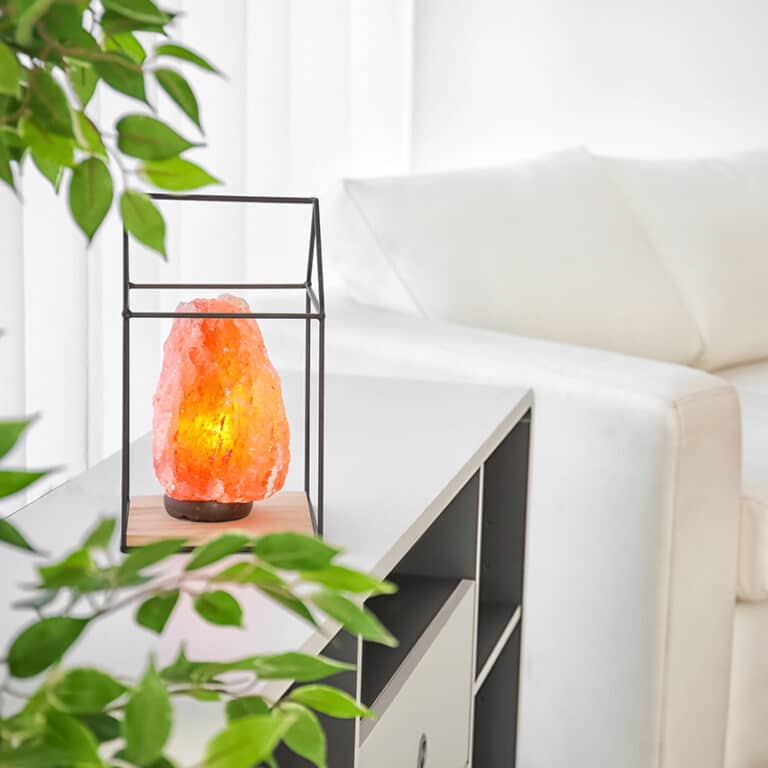You may have heard some of the buzz surrounding Himalayan salt lamps, and you might be wondering what all the fuss is about. Can they really be as healing and soothing as many have claimed, or is it all just hype? And if you’re reading this, you might already know that a salt lamp would be a good addition to your sacred space.
It will.
The History of Himalayan Salt Lamps
The history of the salt that comprises these lamps is spine-tingling and fascinating.
The Himalayan mountains were created around 250 million years ago, as a result of unbearable tension on the tectonic plates of Jurassic Indo-Australia. The deposits of the rosy, ancient salt that we still use today come from the Salt Rock Formation in the Himalayas of Pakistan. These salt deposits have been studied extensively, revealing many captivating characteristics. These minerals inhabited somewhat balmy, dank conditions until Tibet migrated closer and closer to the equator. The blistering sun began to evaporate the Tethys Sea nearly 105 million years ago, resulting in the gargantuan salt beds from which we mine today. These salts are literally hundreds of millions of years old, and their molecules contain ancient wisdom only found in the seemingly immortal.
What’s more, Himalayan salt is comprised of the same elements that encompassed our primordial ocean – that is, a mixture of ancient salts and timeless water. Our blood is similarly comprised of such a solution: a marinade of water, minerals and eternity. In fact, Himalayan salt consists of every element found organically in the human body, such as potassium and magnesium. These minerals are exactly what give Himalayan pink salt its rosy, mesmerizing hue.
While critics and cynics alike might scoff at the supposed healing abilities of a Himalayan salt lamp, it is hard to deny its magical history.
How Salt Lamps Work
Himalayan salt is crystalized and naturally hygroscopic, meaning that it naturally takes in particles of moisture. It can even attract allergens and bacteria, rendering them harmless. You might notice your lamp “crying” – the light bulb provides heat that keeps the salt dry and in turn causes small amounts of condensation to form.
Furthermore, Himalayan salt lamps release negative ions in the air surrounding them.
While “negative” is typically associated with “bad,” negative ions are actually a good thing. Essentially, an ion is comprised of a molecule or an atom that has an electrical charged due to the loss or gain of an electron.
Positive and negative ions exist everywhere. Negative ions are naturally occurring in areas with large amounts of air, sunlight and water. Think about the last time you breathed in refreshing mountain air or felt energized by a long walk on the beach. There was likely a rush of negative ions around you, lifting your spirits.
Negative ions attract positive ions and polluted particles in the air and cause them to lose their electrical charge, taking away any negative energy within these pollutants and sending them, lifeless, to the ground where they won’t bother you. Positive ions decrease the body’s resources of energy, so the fewer positive ions in your space, the better. Negative ions are also helpful in the reduction of electromagnetic radiation – the kind that is emitted from your television, computer or cell phone. Negative ions can protect your health and your energy.
Salt Lamps & Your Mood
If negative ions reach our bloodstream, they are said to be able to improve mood and boost serotonin. There have even been studies conducted by Columbia University that suggest high exposure to negative ions can be just as affective as anti-depressants for Seasonal Affective Disorder. While pharmaceutical anti-depressants do work for some people, they do have side effects that not everyone is willing to experience. Himalayan salt lamps contain no side effects and are safe for anyone to use.
Negative ions also increase oxygen flow to the brain, making you feel more alert and able to focus.
Beyond the negative ions emitted by these lamps, their beautiful, warm glow provides a sense of serenity.
The Healing Properties of Halite
Himalayan salt is, itself, a healing crystal. This is a mineral of purification and cleansing. It deflects negativity and improves mood by regulating emotions. Halite encourages independence and is notably useful for combating loneliness and isolation. Pink halite is especially effective for matters of the heart, healing aches and pains. This crystal purifies the soul and draws out spiritual contaminants, allowing you to feel more connected to your center, your spirit. Halite also provides the mind with clarity, decreasing fogginess and increasing focus.
Beyond Science
Himalayan salt lamps are typically depicted in reference to the negative ions they produce, but this overlooks the healing properties of this ancient, immortal mineral. While there is scientific evidence that negative ions are extremely beneficial for mind and body, Himalayan salt lamps provide much more in terms of healing energy.
From their beautiful glow to their ancient roots and the healing nature of halite itself, these lamps are a must have for anyone who wishes to keep their sacred space filled with positive, cleansed energy.
Related Article: An Empath’s Guide to Protecting Your Aura
